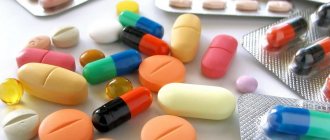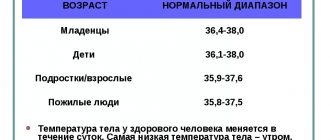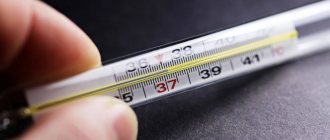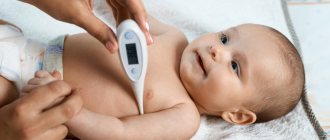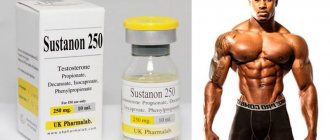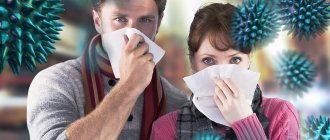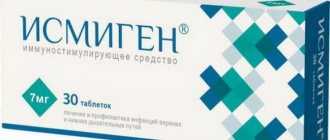A high temperature in a child or adult is always a serious cause for concern. Why does it appear, when you need to urgently see a doctor, and when there is no need to knock it down, how to properly reduce it at home - these and many other questions are answered by the experienced specialists of our clinic.
The most optimal temperature for the occurrence of biochemical processes in the human body is considered to be from 36.5 to 37.2°C. If the thermometer shows deviations of 1 - 1.5 ° C up or down, then it means that there is a malfunction in the body’s functioning. Temperatures up to 39°C are called elevated, and temperatures from 39°C are called high.
Types of temperature:
- The norm is from 35°C to 37°C. This indicator directly depends on many factors: time of measurement, gender, age of the person.
- With hyperthermia – temperature above 37°C. This condition is caused by a violation of the mechanisms of thermoregulation: an excess of heat from the outside or, conversely, difficult heat transfer. For example, too warm clothes, heat and sunstroke, burns, physical activity, etc.
- Fever (fever) is a protective reaction of the body to the appearance of foreign agents in it:
- fungal infection,
- viruses,
- bacteria, bacteria
- pathological process - for example, damage to the nervous system, hemorrhage, inflammation, injury, etc.
During fever, thermoregulation mechanisms are preserved. There are mild fever (38 - 38.5°C), moderate (38.6 - 39.5°C) and high (above 39.5°C). Temperatures above 40.5 - 41°C pose a serious danger to life.
Diagnosis of high temperature without symptoms at Altimed MC
Diagnosis of fever without symptoms in an adult is carried out using modern devices. There are many reasons for the development of the current trait. In order to identify a weak point, it is important to conduct a full functional diagnosis. It is absolutely safe for patients of any age, and is freely used to examine the child’s body.
The main advantages of functional diagnostics:
- quick results;
- absence of pain and discomfort;
- absolute safety;
- high accuracy;
- determination of a pathological condition at an early stage of development;
- checking the functional state of all organs and systems.
This method has virtually no contraindications. It is not recommended to use the modern diagnostic method for pregnant women, people suffering from cancer, or mental disorders.
Is it true that fever is beneficial?
With mild heat, the body's defenses are activated. As soon as an “enemy invasion” occurs, all organs begin to release pyrogen proteins into the blood. They, in turn, trigger an increase in temperature and the production of antibodies and interferon protein, which kill harmful microorganisms. By artificially reducing the temperature with medications, we prevent the immune system from fighting the infection.
It has been proven that at a temperature of 38 - 38.5°C the following processes occur in the body:
- the production of antibodies to the pathogen and interferon is enhanced;
- the reproduction of viruses and bacteria is significantly slowed down;
- the liver more effectively neutralizes toxic waste products of pathogenic microorganisms, and the kidneys remove them faster in the urine;
- increased enzyme activity is observed;
- the bactericidal properties of blood serum and lymph increase.
A slight fever, although its symptoms are unpleasant, helps you recover faster. By knocking it down, we expose ourselves to even greater danger. After taking an antipyretic, a person, of course, will feel much better, but the undefeated infection will remain inside, continue to spread quietly throughout the body and can provoke serious complications on the kidneys, for example, pyelonephritis or cystitis.
When does a temperature of 37.5 to 38°C occur without symptoms?
Temperature without symptoms in the range between 37.5-38°C is observed:
- for problems with the thyroid gland;
- tuberculosis;
- allergies;
- neurological diseases;
- oncology;
- pneumonia;
- gastroenterocolitis;
- viral hepatitis A.
Do not forget about such serious diseases that occur with an increase in temperature, such as:
- systemic lupus erythematosus, rheumatism, other autoimmune processes;
- endocarditis, myocarditis;
- syphilis, gonorrhea, genitourinary infections;
- rubella, measles, other viral infections.
How to help the body with fever?
- Do not increase the temperature artificially.
Do not take a hot bath, do not steam your feet, do not apply mustard plasters and alcohol compresses, do not drink alcohol, hot milk, tea, coffee, do not wrap yourself in blankets.
- Drink plenty of fluids.
The drink should be plentiful and warm, maybe at room temperature, and always unsweetened. The best is mineral water with lemon, lingonberry or cranberry juice. The blood becomes more fluid, toxic substances are eliminated faster, and the body does not suffer from dehydration. Sugary drinks are dangerous because water will come out along with sweat, and glucose will become an additional source of food for pathogens.
- Sweat properly and stay in bed
Intense sweating is a natural mechanism of thermoregulation during fever. As sweat evaporates from the skin, it cools the body and prevents it from overheating. By wrapping the patient in several blankets and insulated pajamas, we prevent sweat from evaporating. A person with a fever should wear cotton clothing and lie under a light, thin blanket. When clothes get wet, they need to be changed.
- Cleanliness and fresh air.
The room should be clean and well ventilated. As a rule, a sick person breathes through his mouth, which means that an infection will quickly enter his lungs along with moist, stale air. The air temperature in the room should be approximately 22°C - 24°C. It is extremely important that there are no drafts.
- Do not wipe your body with vodka or alcohol.
Alcohol vapor evaporates very quickly and causes sudden hypothermia and severe chills. It is best to wipe the body with a sponge soaked in warm water, or put the patient in a cool bath for a while.
- Food should be light
During illness, everything fried, salty, fatty, spicy, and alcohol should be excluded from the diet. The best choice is low-fat broths, juices, fruit drinks, fresh and boiled fruits and vegetables.
What to do if the temperature does not go away?
Contact the clinic. If you cannot determine which specialist you need, you should start with a therapist - he will assess your general condition and recommend that you take tests that will give a more objective picture (usually a general blood and urine test).
Our clinic provides a full range of medical services in all areas - our allergists, surgeons, gynecologists, urologists, gastroenterologists, and dozens of doctors of other specialties will provide you with qualified assistance. Here, in the clinic, you can undergo all the necessary tests. A serious plus is that all examinations and treatment measures will be carried out at a time convenient for you.
If you have previously been diagnosed with diseases that have become chronic, be sure to inform the doctor about them during your appointment - this will make it easier for him to navigate the list of examinations that you need to undergo.
How to lower the temperature correctly and in what cases should it be done?
You need to start lowering the temperature if it is above 38-38.5°C, lasts more than 3-5 days, or the thermometer is approaching 40°C. You can do this in the following ways:
- the patient should drink plenty of warm, unsweetened liquid;
- Cold compresses placed on the forehead, neck, wrist, armpits and groin areas help well, as well as cool foot baths and wrapping in a wet sheet;
- Rubbing should be done like this: moisten a towel in warm water, first wipe your face, and then your arms, body and legs;
- A cooling bath will help lower your temperature and wash away toxins. First, the patient is placed in a warm bath, then cold water is gradually added to it to a temperature of 30 ° C;
- Only a doctor can prescribe antibiotics. Before his arrival, you need to take antipyretic medications.
Why choose Altimed MC for the treatment of high fever without symptoms
Treatment, if the temperature does not show signs of a cold, is carried out at the Altimed Medical Center. Why is it important to contact us? The main advantages are:
- non-invasive effect on the body (without pain and discomfort);
- Individual approach to each client;
- innovative technical equipment;
- effective treatment plan;
- affordable price range.
From us you can purchase devices for treatment at home. For additional information, please contact the indicated phone numbers.
When is it necessary to urgently call an ambulance?
- The thermometer shows above 39.5°C.
- An increase in temperature is accompanied by abdominal pain (especially in older people and children), vomiting, weakness, limited movement, visual disturbances, or severe tension in the neck muscles (a person cannot tilt the chin to the chest).
- Children under 10 years of age have a very dry, barking cough. In combination with temperature, this symptom indicates an inflammatory narrowing of the larynx (false croup).
- If the temperature rises above 38°C very sharply, within 1-2 hours. This is especially dangerous if a child under 6 years of age is sick and has previously experienced convulsions in the heat - in this case, even a low temperature of 37.5 ° C is fraught with serious consequences.
- Mild fever is dangerous for people with seizures and cardiovascular disease.
If elevated temperature is accompanied by weakness, pain in joints and muscles, blurred vision, consciousness, headache, convulsions, difficulty breathing, you should immediately consult a doctor. Also be sure to make an appointment if a slightly elevated temperature lasts more than 7 days.
The concept of normal for body temperature
Normal body temperature is considered to be 36.6°C, but this figure can fluctuate. The lowest value is observed in the morning, the maximum in the evening. An increase in temperature is facilitated by eating, drinking alcohol, exercising, stimulating the nervous system, being under the sun, or in a steam room. It is considered normal if a person’s temperature is 36.2°C in the morning and 36.7°C in the evening. A peculiarity of the female body is that the temperature decreases a few days before ovulation and increases when ovulation occurs.
The norm for an adult is considered to be between 35°C and 37°C, for children under 3 years of age – up to 37.5°C. In summary, a temperature of 35°C should not cause panic.
How to measure temperature:
- if you measure under the armpit, then a value of 36.6°C is considered normal;
- if in the mouth, then the indicator is half a degree higher;
- if in the rectum, then to get the result subtract 1 degree from the value on the thermometer.
The range from 37.1°C to 38°C is considered to be above normal. If low-grade fever persists for a long time, measures must be taken. An indicator of 38.1°C is already a high temperature that requires urgent help for the body.
Why is fever dangerous in children, and how to deal with it?
advises a medical pediatrician. Fever is the most common sign of the development of infectious and some other diseases in children.
Many things can cause a child to have a fever, from common childhood illnesses such as chicken pox and tonsillitis to reactions to vaccinations. An increase in body temperature is an innate protective mechanism by which the body stimulates the functioning of the protective factors of the immune system. Also, the increased temperature of the internal environment of the body itself can lead to inactivation or death of pathogens of many diseases. Remember that everyone's body temperature normally fluctuates 1-2 degrees throughout the day and may vary depending on age, activity level and other factors.
So rising temperatures are not a “problem.” This is an indicator that some kind of attack by microbes, viruses or other factors has occurred on the body, and the body reacts to it, gives a “response”. It is much worse when bacteria or viruses attack, but the temperature does not rise (i.e. there is no immune response, or it is insufficient).
How to reduce a child's temperature?
Now let’s talk about the medications that should definitely be in your first aid kit if a baby is growing up in the family. Thus, pediatricians prohibit the use of drugs such as:
- Aspirin;
- Analgin;
- Nise.
The baby can only be given medications that contain Paracetamol or Ibuprofen. Even if the child has no symptoms, they must be correctly calculated based on the baby’s weight and measured using a special syringe or measuring spoon. You should not use ordinary teaspoons for these purposes, and it is better to completely forget about the concept of “by eye”.
How to reduce a child's temperature?
Doctors advise using only one drug from the above - with Paracetamol or Ibuprofen in the composition. If the temperature drops poorly or does not drop at all, such medications can be alternated. But you can’t give your baby the combined drug Ibuklin.
Please note that it is not at all necessary to reduce the temperature to normal. It is enough just to knock it down a little for the baby’s well-being to improve at least a little. Don’t forget to feed your little one, because in case of high temperature the loss of fluid increases. Pediatricians say that babies need to drink 100 ml of water per 1 kg of weight.


